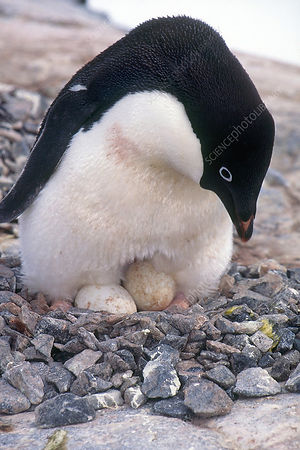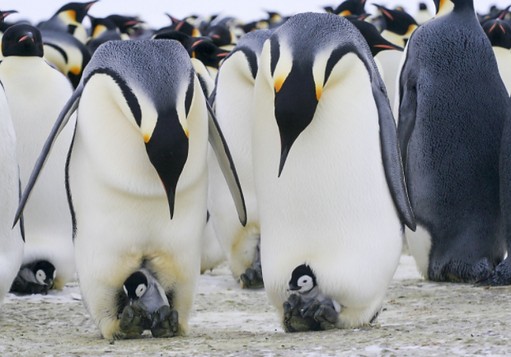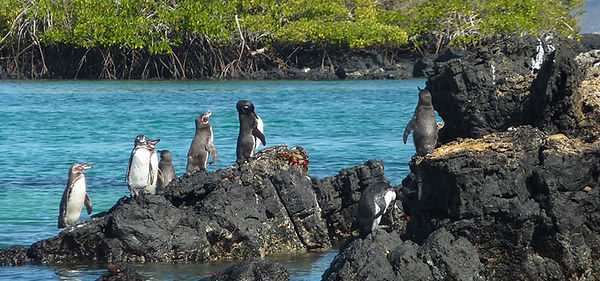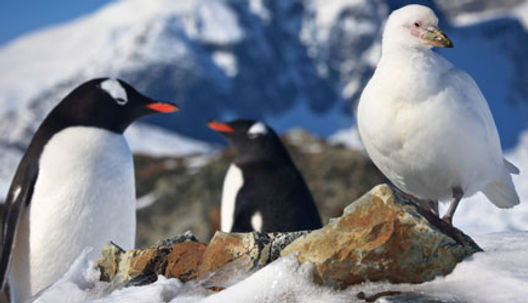
Please let me know if my assignments have incorrectly ordered words! Some devices mix up the order of my paragraphs...
Narrative Statement

(1) Penguins in colder climates are often found in groups to retain heat and to have the advantage in numbers if they were ever in danger.
(1) Different species of penguins have different breeding requirements. For this species, they make nests out of rocks.


(4) Penguin eggs are kept warm by the fathers, who stand over their eggs and warm them with a pouch of skin.

(6) Once the chicks have hatched from the eggs, the fathers continue to keep them warm.

(1) Different penguin species are native to a range of habitats and climates, such as this group of penguins in a warmer environment.
(5) Even in colder environments, penguins are not the only organisms, such as this snowy sheathbill living in the same location as these penguins.

My service experience was spent on Zooniverse (https://www.zooniverse.org/), working on their “Penguin Watch” project. Zooniverse allows people to take part in online science data collection. The “Penguin Watch” project is dedicated to monitoring the penguin populations and to understanding their survival rates and breeding times. Participants count the penguins, chicks, eggs, and other organisms in different images shot of penguins in their natural habitats. Choosing to take part in this project was an easy decision to make, as I used to love spending time looking through books and images of penguins as a child. The presented task of counting the penguins appeared simple to complete, so I decided to take part in the project. Completing the number of classifications required for the 6 hours of service was not as simple, however, as it required 300 classifications for 6 hours. Many of the photos overlooked a very large population of penguins in one location, resulting in more time spent identifying each of the penguins. Some of the photos were also difficult to identify what was in it due to quality and/or lighting issues. Though there was an option to identify any other organisms that were not penguins, such as gulls or people, most of the photos that were presented did not have other species present. This could be an indicator towards either a hostile nature

toward other organisms or the harsh environmental conditions that other organisms are unable to handle. Another surprise during the service experience was the range of different habitats that the photos were taken in. Penguins are often associated with polar landscapes caked with snow and ice, when in reality, certain species can thrive in a range of higher temperatures and are found in many other locations around the world. For example, “Gentoo penguins are widely distributed across the Southern Ocean and inhabit many of its islands and coasts,” and “…have a strong preference for breeding around waters of high primary productivity across a range of temperature and salinity levels,” (7). Many of the presented photos had snow and ice present, though there were varying levels that showed how each habitat had slightly different conditions. Some did not contain any snow and had a rocky or grassy terrain, which
(8) Another example of the warmer environments of penguins
expands beyond the temperature range needed to keep solid snow and ice. It was also surprising to see mostly adult penguins in the photos, and in comparison, it was rare to find any penguin chicks or eggs. This can potentially be due to their breeding times being very specific and not as frequent. It led me to become more aware that this may be dangerous for the overall population if there was a disruption in their lifestyles, such as the changes brought to their habitats due to environmental harm caused by people. We can observe currently that penguins are declining in population. “Of the world’s 18 penguin species, eleven are undergoing population declines, for which ten are classified as ‘Vulnerable’ or ‘Endangered’,” (3). With the consequences of human actions on the environments around us, many species of animals face potential harm in their way of life and their surroundings. With penguins specifically, the rise in global temperatures due to the burning of fossil fuels and an increase in carbon dioxide has begun melting ice in colder regions, decreasing the living space for penguins, and also making it harder for them to breed. Even with penguins that do not live upon ice, the rise in global temperature will affect their lifestyles, such as their food supply and body functions, as many organisms are only suited to survive in certain conditions.
Through the ‘Penguin Watch’ project, I have been able to grow more aware of not only the lifestyles of penguins, but the potential threats to the stability of their populations. Though I am only one person in a world filled with millions and have little impact on large-scale events such as mining, I can attempt to make a small difference in the future of penguins. Actions such as turning to environment-friendly sources of power, like solar energy, decreases the amount of fossil fuels used. Reducing my own carbon footprint by walking or carpooling can also help. Supporting organizations devoted to the environmental conservation of penguins, such as the Wildlife Conservation Network (2), can aid those who are able to take larger steps in the successful management and preservation of penguins. Additionally, taking part in other research studies centered around penguins, such as the ‘Penguin Watch’ project, can also help those with more capabilities to create solutions to the problems faced by penguins today and in the future. This service experience has informed me of the certainties and uncertainties of the lives of penguins in both the present and future. By providing the chance to participate in research, it has also helped me realize the dangers that humans can cause, and the possible changes that we can make for the better.
(1) “10 Cool Facts About Penguins.” City of Albuquerque, cabq.gov/artsculture/biopark/news/10-cool-facts-about-penguins.
(2) “Global Penguin Society.” Wildlife Conservation Network, 10 Feb. 2021, wildnet.org/wildlife-programs/penguin/.
(3) Hickcox, Rachel P., et al. "Global Terrestrial Distribution of Penguins (0RW1S34RfeSDcfkexd09rT2Spheniscidae1RW1S34RfeSDcfkexd09rT2) and their Conservation by Protected Areas." Biodiversity & Conservation, vol. 28, no. 11, 2019, pp. 2861-2876. ProQuest, https://www.proquest.com/scholarly-journals/global-terrestrial-distribution-penguins-i/docview/2240387688/se-2?accountid=14068, doi:http://dx.doi.org/10.1007/s10531-019-01801-z.
(4) Lepp, George D. “Adelie Penguin with Eggs.” SCIENCEphotoLIBRARY, Science Source, sciencephoto.com/media/1011063/view/adelie-penguin-with-eggs.
(5) “Other Birds.” Oddizzi, oddizzi.com/teachers/explore-the-world/places/antarctica/wildlife-antarctica/birds/.
(6) Quenqua, Douglas. “Emperor Penguins: Good Dads, but Less Dedicated Than You May Have Thought.” The New York Times, The New York Times, 9 Jan. 2018, www.nytimes.com/2018/01/09/science/emperor-penguins-dads.html.
(7) Pertierra, Luis R., et al. "Cryptic Speciation in Gentoo Penguins is Driven by Geographic Isolation and Regional Marine Conditions: Unforeseen Vulnerabilities to Global Change." Diversity and Distributions, vol. 26, no. 8, 2020, pp. 958-975. ProQuest, https://www.proquest.com/scholarly-journals/cryptic-speciation-gentoo-penguins-is-driven/docview/2420320649/se-2?accountid=14068, doi:http://dx.doi.org/10.1111/ddi.13072.
(8) “Subject 59088206.” Zooniverse, zooniverse.org/projects/penguintom79/penguin-watch/talk/subjects/59088206.